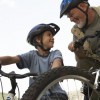Abstract
As children continue their preschool years, they learn many new things and develop their own opinions and ideas. During this time, people inside and outside of the home may greatly influence them. As preschoolers continue to learn and grow, caregivers can take many steps to guide their children in a healthy and positive direction. This 4-page fact sheet was written by Kate Bennet, Gail Kauwell, and Karla P. Shelnutt, and published by the UF Department of Family, Youth and Community Sciences, April 2014.
References
American Academy of Pediatrics. (2010). Feeding and nutrition: Your 4- to 5-year-old. Retrieved from http://www.healthychildren.org/English/ages-stages/preschool/nutrition-fitness/pages/Feeding-and-Nutrition-Your-4-to-5-Year-Old.aspx.
American Academy of Pediatrics. (2011) Developmental milestones: 3-to 4-year olds. Retrieved from http://www.healthychildren.org/English/ages-stages/preschool/pages/Developmental-Milestones-3-to-4-Year-Olds.aspx.
Centers for Disease Control (CDC). (2011a). How much physical activity do children need? Retrieved from http://www.cdc.gov/physicalactivity/everyone/guidelines/children.html.
Centers for Disease Control (CDC). (2011b). Making physical activity a part of a child's life. Retrieved from http://www.cdc.gov/physicalactivity/everyone/getactive/children.html.
Centers for Disease Control (CDC). (2012a). Child development: Preschoolers (3-5 years of age). Retrieved from http://www.cdc.gov/ncbddd/childdevelopment/positiveparenting/preschoolers.html.
Centers for Disease Control (CDC). (2012b). Important milestones: Your child at four years. Retrieved from http://www.cdc.gov/ncbddd/actearly/milestones/milestones-4yr.html.
PBS Parents. (n.d.). Keep kids active. Retrieved from http://www.pbs.org/parents/food-and-fitness/sport-and-fitness/keep-kids-active.
Satter, E. (2012a) The picky eater. Retrieved from http://www.ellynsatter.com/the-picky-eater-i-43.html.
Satter, E. (2012b) Ellyn Satter's division of responsibility in feeding. Retrieved from http://ellynsatterinstitute.org/dor/divisionofresponsibilityinfeeding.php.
USDA. (2011). Snack ideas: Kid-friendly veggies and fruits: 10 tips for making healthy foods more fun for children. Retrieved from http://www.choosemyplate.gov/foodgroups/downloads/TenTips/DGTipsheet11KidFriendlyVeggiesAndFruits.pdf.
USDA. (n.d.). Grains: What counts as an ounce equivalent of grains? Retrieved from http://www.choosemyplate.gov/food-groups/grains-counts.html#.
USDA. (n.d.). Fruits: What counts as a cup of fruit? Retrieved from http://www.choosemyplate.gov/food-groups/fruits-counts.html.
USDA. (n.d.). Vegetables: What counts as a cup of vegetables? Retrieved from http://www.choosemyplate.gov/food-groups/vegetables-counts.html.
USDA. (n.d.). Dairy: What counts as a cup in the dairy group? Retrieved from http://www.choosemyplate.gov/food-groups/dairy-counts.html.
USDA. (n.d.). Protein foods: What counts as an ounce equivalent in the protein foods group? Retrieved from http://www.choosemyplate.gov/food-groups/protein-foods-counts.html.
USDA. (n.d.). Snack ideas. Retrieved from http://www.choosemyplate.gov/preschoolers/healthy-habits/snack-ideas.html.
USDA. (n.d.). Health and nutrition information for preschoolers. Retrieved from http://www.choosemyplate.gov/preschoolers.html.
USDA. (n.d.). Set a good example. Retrieved from http://www.choosemyplate.gov/preschoolers/healthy-habits/set-a-good-example.html.
USDA. (n.d.). How much physical activity is needed? Retrieved from http://www.choosemyplate.gov/physical-activity/amount.html

